Published - 16 min read
Total Solar Eclipse 2024

Celestial Bodies Aligning
April 8, 2024, was a date that had been marked in my calendar all the way back in 2017. That was the last time a total solar eclipse occurred in North America, back on August 21, 2017. I happened to be in San Francisco connecting on a flight that day and was able to catch a partial view of the total eclipse.
Even though I did not get to view the totality of that eclipse, it definitely was an experience that unlocked excitement in me to learn more about eclipses.
Getting Prepared for the Eclipse
Ironically, we can plot eclipses over thousands of years with extremely high accuracy, but we can’t predict our weather for more than a few days. It all comes down to orbital mechanics and geometry. Who said math isn’t important anymore? NASA actually publishes charts of eclipses over 5,000 years. Take a look here.
Looking at NASA’s eclipse charts, there were two occurring over North America in 2023 and 2024. This was a rarity to have two solar eclipse events occurring within a few months of each other, as well as the path of totality for both going right through Texas, my home.
The first event was an annular solar eclipse on October 14, 2023. I made a whole weekend trip out to Sonora, Texas, to experience and photograph that eclipse. While not a total solar eclipse since the moon only partially obscures the sun and creates what is known as the “ring of fire,” it was excellent practice for the more complex process of photographing the eclipse. Take a look at that blog post about the incredible trip to photograph the annular eclipse and night-time astrophotography while camping at Fort Davis Mountains State Park. View Annular Eclipse blog post here.
That eclipse event was great practice and helped me get ready for the process of doing solar photography. I knew what to expect and the exact setup I would need for my camera and gear.
Eclipse Mania Hits
For weeks before the eclipse, I have been seeing towns and events planning for the eclipse and the thousands of tourists coming to the area to witness it. People were flying in from all over the world to Austin, San Antonio, and Dallas to be able to witness it. Living in Austin, I was fortunate to be able to drive to many locations to view it.
I spent the weekend driving out, scouting for locations to set up and photograph the eclipse. I knew that with the weather being variable, I had to be ready to drive anywhere. Luckily, my setup is compact and fits in the back of the car easily. I also knew, seeing the crowds showing up and flooding into all the small towns in the Hill Country of Texas, that it was going to be a madhouse rush of people everywhere. So flexibility was definitely needed.
Clouds, Clouds, and more Clouds
No matter how much preparation and planning you put into any outdoor event, weather is always a variable you can never predict. Back in October, during the annular eclipse, I remember telling the people there who were also witnessing it who were excited about the upcoming total eclipse that the weather in Texas in April is truly unpredictable and a little crazy.
Sure enough, fast forward to a few days before April 8th, and the weather forecast shows nothing but dense high and low clouds for that day across the entire state of Texas. Each day before the eclipse, I was constantly checking the weather and cloud forecast, and it was not changing. The meteorologists were fairly certain, even on April 7th, that the clouds were going to be blocking our view all over Texas. Conditions just weren’t looking good since a cold front stalled right over Central Texas and gulf moisture was being pumped into the atmosphere.
I was checking cloud cover forecasts all over the path of totality, including Del Rio, Junction, Llano, Waco, and many more towns in Central Texas. No matter what location I looked at, the cloud clover forecast was at least 50% or more cloud coverage on that day. I was getting stressed and finally resigned to the fact that the weather may ruin the view on the day of the eclipse. Ironically, the weather in Vermont, Maine, and eastern Canada was actually clear skies, which notoriously have far more cloudy days than Texas.
Picking the Final Spot
Finally, on the night before the eclipse, which was a Sunday, I knew that I had to eventually pick a final spot. I couldn’t keep driving all over Texas, or I was going to miss the main event. My best chances were to go as far west as possible to the path of totality since the weather forecast was showing the clouds could possibly be thinner the further northwest I went from Austin. The final choice was Brady, Texas, which is about a two and a half-hour drive from Austin.
I got all my equipment ready and made sure all the batteries were charged. I packed it all up in the car and headed over to pick up my friend, Rene, who was going with me as well to see the eclipse. Finally, on our way heading out of Austin, I could definitely see the clouds early in the in the morning; sunshine was peaking through, so I was very cautiously optimistic of clearing skies.
We headed out from Austin westward on State Highway 29, driving through a very scenic and pretty part of Texas known locally as the Hill Country. The wildflowers were in full bloom, including the bluebonnets. Most people don’t know that the State of Texas actually has a program to seed the highway right-of-way with wildflowers. This program was championed by the late Lady Bird Johnson, the wife of President Lyndon B. Johnson, whose passion was beautifying spaces with flowers. So next time you drive through Texas, do it in the springtime, from March through April, to see the wildflowers fully blooming.
As we passed through the small town of Llano, traffic was definitely picking up, and looking at the license plates, cars were from all over the country, all getting ready to watch the eclipse. After driving through Llano, we were heading towards Brady, and we drove past a small community cemetery, which is very common in rural Texas. This roadside cemetery was a great location because it was set far enough off the highway to be safe and had a small, paved parking lot. I knew this was the spot because the clouds had started to clear, it was far enough away from the huge crowds in the towns, and the sheriff’s department and Texas Highway Patrol would not harass us since we were off the highway. Most importantly, there were no obstructions to the sky, and I was getting more optimistic that the sky was starting to clear.
Setting Up for the Eclipse
I started setting up my gear, and René was relaxing while waiting for the event since it was around 10 a.m. and we still had a few hours before the eclipse would start. For this shot, I had the following gear:
- Sony A7C II Mirrorless Digital Camera
- Tamron 50-400mm 𝑓/4.5-6.3 A067
- Thousand Oaks Optical SolarLite threaded camera filter 67mm
- Magnus Aluminum Travel Tripod with Magnus GH-M1 Gimbal Head
- Ecoflow River 2 Max portable power station
- iPad (for connecting to camera)
- Small portable foldable table
- Solar glasses (purchased a pack back in October from B&H Photo Video)
The one item I don’t have yet and am looking to eventually acquire is a star tracker. This would solve the issue of having to manually move and adjust the camera as the sun and stars move in the sky, or rather, as Earth spins, the sky moves. This is extremely useful for solar photography and long-exposure shots like night-time astrophotography. But solar photography can be done without a star tracker. It just requires manual adjustments every few minutes to keep the sun in the frame. The gimbal head makes this easier because, after balancing the camera, I can make minute adjustments with my hands.
I used my small camping table to set up my iPad and Ecoflow portable power station. The iPad was used as a remote controller and viewfinder. This is so I don’t have to touch the camera during operation, and I can also easily change settings. The Ecoflow keeps everything powered up. Even though I had charged all the batteries, I did not want to risk the batteries dying since this would take a few hours.
I screwed on my Thousand Oaks solar filter to the Tamron lens. This filter is important not only to be able to photograph the sun but also to protect the camera equipment from the extreme brightness of the sun. I made a small mistake at this point. I have a habit of screwing my filters onto my lenses pretty snugly so they don’t accidentally unscrew off. But, in this case, I should have left it screwed on very loosely. This would make it easier to take off during totality. When totality occurred, I went to unscrew the filter, and it was tight. When I went to take it off, the camera moved, and I had to reframe the eclipse. So next time, I know, leave the filter on loosely. There are some filters that you can just slip on and off, or even homemade ones with filter sheets and cardboard.
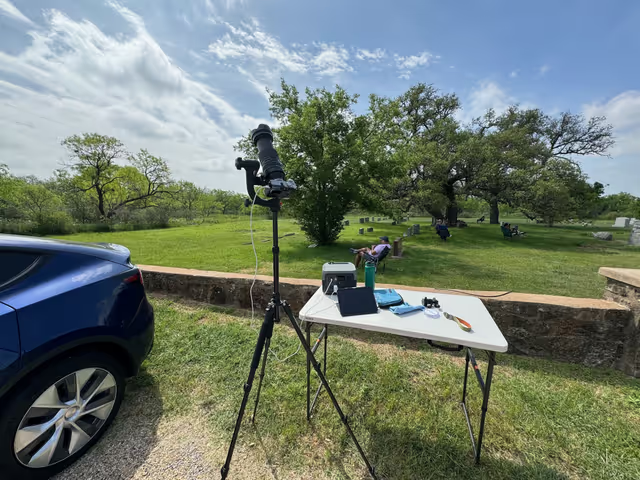
As I was setting up my gear, other onlookers who were driving past had the same idea and decided to stop at the roadside cemetery too. By 11 a.m., the entire parking lot was full, and there was a crowd forming. People from all over the world were there, so it was a great experience sharing it with other people too. I met a bunch of really nice people from the UK, North Carolina, and California. They were from everywhere to share the experience. Others had some really cool equipment, like Michael, who had an awesome Dobsonian telescope to view the sun in real time. It was an awesome setup, and now it makes me want to get my own telescope.
Photographing the Eclipse
From my practice run on the annular eclipse back in October, I had a good idea of what camera settings I needed to use for this shot. The solar filter, of course, is designed to block almost all light, and the one I used is an equivalent 16-stop reduction. So I had to bring my ISO up pretty high to be able to keep a fairly fast shutter speed too, which is necessary for any solar photography. The good thing about newer Sony cameras is that they have really good high ISO performance, so I knew I could keep a higher value and not have too much noise that could be removed in post. My initial camera settings for the beginning of the eclipse were:
- Full manual mode (needed to control everything here)
- Focus mode on DMF (direct manual focus)
- Focal length 400mm
- Shutter speed 1/800s
- Aperture 𝑓/6.3
- ISO 2500
- Auto White Balance
By noon, the low morning clouds were totally gone, and only some high-level clouds were streaming past. I was getting more optimistic about the viewing chances at this point. I started snapping off some initial shots and double-checked that my settings were good. Using the iPad to remotely control and view the photos is good here because I can get the sun in the frame, check the focus, and then use the iPad to trigger the remote shutter so I don’t shake or move the camera during shutter release. I could use a timer too, but I prefer to just remotely trigger the shutter.
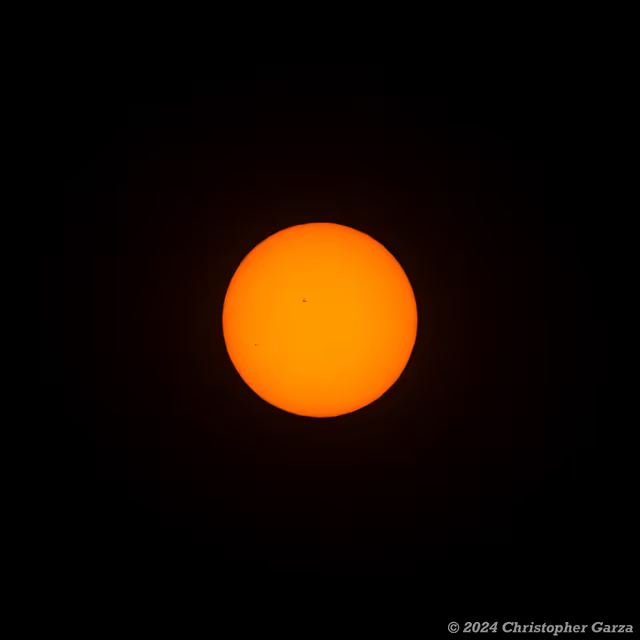
We could all start to see a chunk of the sun getting obscured by the moon through solar glasses. Snapping off more photos, I could already see the chunk there too.
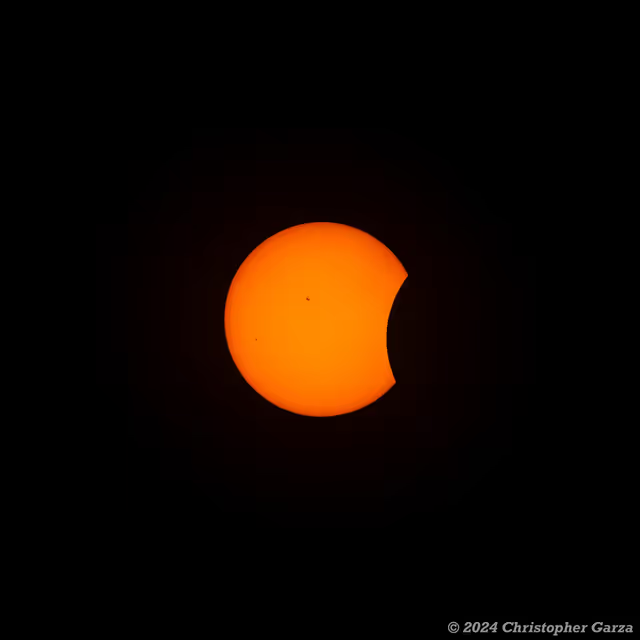
Few minutes after start of eclipse, 1/800s, 𝑓/6.3, ISO 2000
Then drama started to occur. High clouds started to stream back over again. You could hear a collective sigh and grumble from the crowd for the clouds to move on. The clouds actually added a bit of depth to the images and some cool effects. Honestly, most solar photography in general is a bit flat and lacks the depth to make it feel real. I got a few shots off with clouds that came out quite nice after the post. Once the clouds started covering the sun, I really had to bump up the ISO to 4000 and slow the shutter speed down to 1/640s to keep the exposure level right.
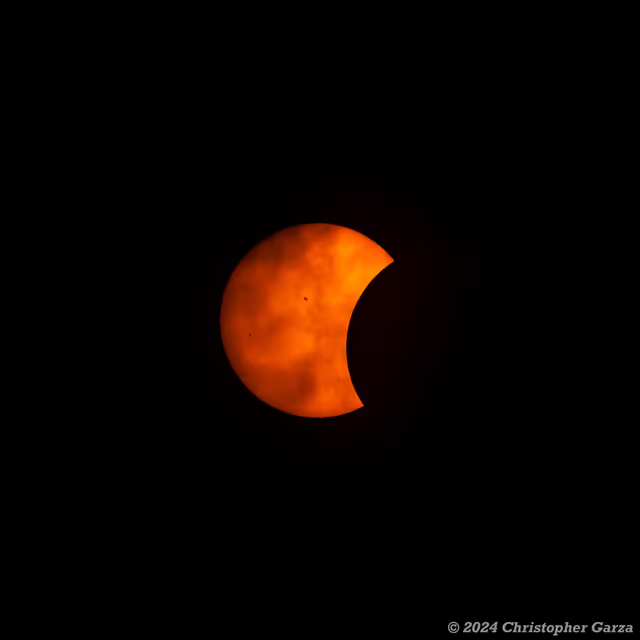
Clouds were streaming past off and on. We were all going with the flow. You finally realized you had to let go and just enjoy the show.
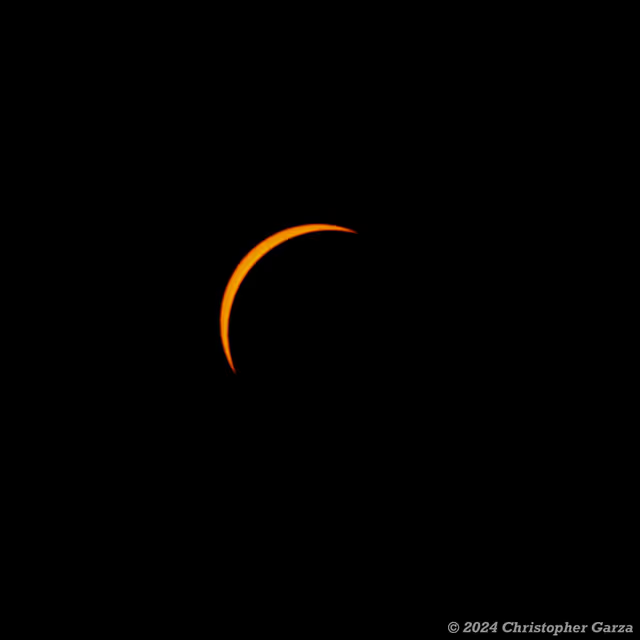
The eclipse is nearly at maximum, 1/640s, 𝑓/6.3, ISO 3200
Maximum of Eclipse Occurs
Getting nearer to totality, the light is, of course, changing drastically. The entire landscape feels so different and ethereal. It is so difficult to describe in words since it is such an extremely rare event to witness. Even the annular eclipse totality could not prepare me for what I would see during the total solar eclipse. Just before the maximum of the eclipse, the landscape was changing colors, stars and other planets were visible in the sky, and as if some other force were at work, the clouds instantly disappeared.
At 1:34 PM, the maximum of the total eclipse occurred, and the whole world around was darkened. It was not so much nighttime, but closer to what it feels like during sunset. The light was so different, almost stretching out in a very saturated sort of way. The whole world felt like it had completely stopped. It was so quiet that even the wind had stopped blowing. Just a few passing cars on the highway were the only noise heard. Even the entire crowd watching was quiet now. We were all just watching an incredible event of celestial bodies dancing above us in a harmonious fashion.
At this point, I remove the solar filter and quickly adjust the shutter speed and ISO to account for the rapid change in lighting. During this moment of quick change and excitement, I made a small rookie mistake. As I said before, I had screwed the solar filter on my lens too tightly, and as I was unscrewing it, I accidentally moved the camera and bumped the focus ring just ever so slightly. Luckily, I recovered fairly quickly and brought it all back into frame. I started to take rapid-fire shots since I only had four minutes of maximum during totality.
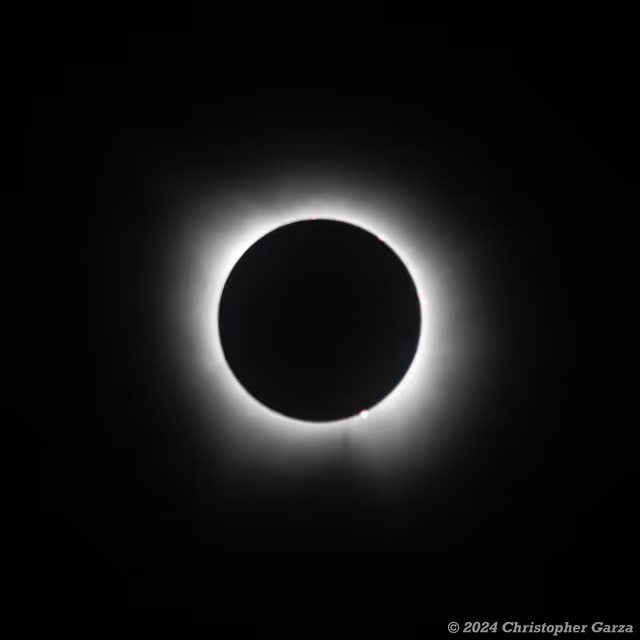
Of course, I also took the time to look around, take in the moment, and not watch the whole event through the camera viewfinder. I was seeing stars in the middle of the day, rapid color changes in the landscape, and most incredibly, seeing the actual corona of our star. Witnessing the corona of the sun is so incredible. The movement of it and the streamers coming out are so beautiful to see. Also, seeing the Baily’s beads effect or the “diamond ring” was also incredible. This effect is caused by the rough topography of the surface of the moon, and this uneven terrain lets “beads” of sunlight shine through.
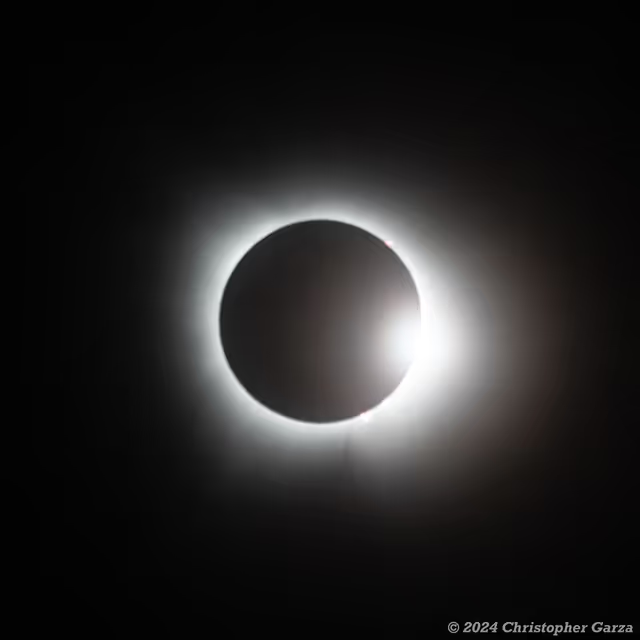
Solar eclipse near end of maximum, 1/400s, 𝑓/6.3, ISO 800
And, just four minutes later, the sun began to peak back out as the moon continued on its trajectory. The sky started lighting back up slowly, and the landscape was getting bright again. I put the solar filter back on my lens and adjusted my shutter speed and ISO. This time I only barely screwed it on and put my solar glasses back on as well.
Everyone was so excited, still watching the sun come back as a tiny sliver, then slowly growing in size. People were clapping and “oooing and ahhing” at the spectacle.
Unfortunately, our respite from the clouds had just as suddenly ended as it had begun, with another band of clouds streaming in. But none of us could really complain because some force was at work to give us that free moment of clear skies during the eclipse maximum. I kept taking a few more shots every few minutes, but eventually the high clouds got too thick, and I was unable to really get any good shots after a while. So a bit later, I started packing up, as did everyone else around.
Post Editing and Final Thoughts
After importing my photos into Lightroom, I was able to see the eclipse all over again on my screen. Now, I am already planning a trip to the next total solar eclipse in 2026 in Spain. The next total eclipse in North America will not be until 2045, so we have a while to wait on that one here.
The editing process was fairly simple on these since really only minor adjustments were made here. Generally, on most of the photos, I made these adjustments:
- Lowered Highlights, Shadows, and Blacks
- Increased Whites, Texture, and Clarity
- Very subtle S-curve adjustment to the Tone curve
- Depending on the photo, made very small increase in Luminance on Red and Orange in the Color Mixer
- Increased sharpening
- Applied AI Denoise at level 60 and 70 on the really high ISO shots
- Applied Lens Corrections using the lens profile in Lightroom
Since my solar filter produces very saturated colors from the sun, I did not want to mess with any major color mixing or color grading here. I am not trying to be as artistic in these shots and just really produce the real result with minor enhancements and corrections.
I decided to make a composite photo of the different stages of the eclipse as well. Since I was unable to capture the ending of the eclipse due to the clouds, I decided to take a different approach and make the composite asymmetrical in the stages. I think it came out pretty good.

As I always say, I am definitely not the expert here or even close to being a professional. For me, this is all about having fun with the hobby and learning something new each time I go out and photograph anything.
If you did not get to see the eclipse yourself, I hope that looking at my photos of it gives you an idea of just how beautiful and awesome an experience it was for me. I am thrilled to have experienced it and get to share it with you now.
Feel free to take a look at the full album, which has larger size images. If you have any questions on how I shot and edited these photos, send me a message here.
Thanks as always for stopping by and watch out for the Squatch!